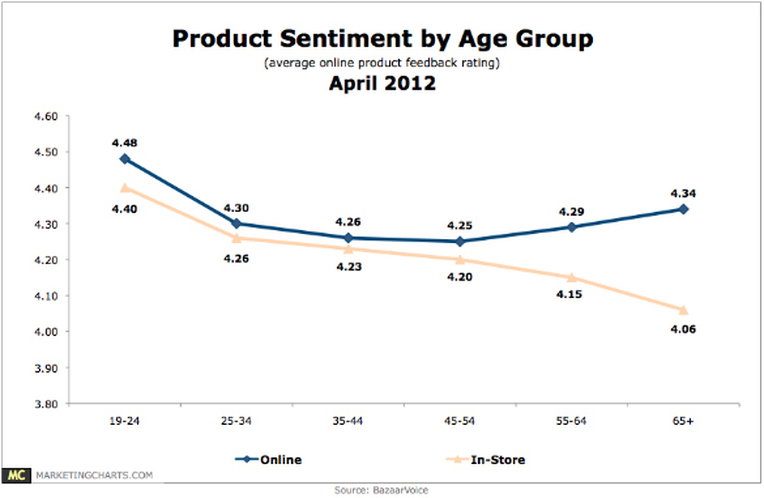Consumers Happier With Products Bought Online Than In-Store
Consumers who buy products online appear more satisfied with their purchases than in-store shoppers, a trend that surprisingly is magnified among the more mature age demographics, details Bazaarvoice in a March 2012 report. Looking at online feedback from both in-store and online shoppers, the company found that the average feedback rating among 19-24-year-olds was 4.48 for their online purchases, compared to 4.40 for their in-store purchases. However, those aged 55-64 were much more likely to report satisfaction with their online than offline purchases (4.29 vs. 4.15), as were those over 65 (4.34 vs. 4.06).
Offline Consumers Generate Plenty of UGCOnline feedback is not dominated by online shoppers, as one might expect. In fact, the analysis found that in-store purchasers were just as likely to contribute online feedback as online purchasers, with user-generated content split evenly between both groups.
Offline Consumers Generate Plenty of UGCOnline feedback is not dominated by online shoppers, as one might expect. In fact, the analysis found that in-store purchasers were just as likely to contribute online feedback as online purchasers, with user-generated content split evenly between both groups.
Offline Consumers Generate Plenty of UGCOnline feedback is not dominated by online shoppers, as one might expect. In fact, the analysis found that in-store purchasers were just as likely to contribute online feedback as online purchasers, with user-generated content split evenly between both groups.
At the same time, although the largest volume of feedback (regardless of purchase channel) comes from consumers in the 35-65 age range, in-store shoppers aged 19-24 are more likely to go online to offer feedback for product purchases, with the likelihood of in-store shoppers doing so decreasing with age. Younger consumers’ propensity to provide feedback is likely related to the importance they place on user-generated content: January 2012 survey results from BazaarVoice indicate that 84% of Millennials (born between roughly 1977 and 1995) report that UGC has some (59%) or a lot (25%) of influence on what they buy, compared to 70% of Boomers (born between roughly 1946 and 1964).
Women Enjoy In-Store Purchases More Than MenData from BazaarVoice’s latest survey appears to lend some weight to the stereotype that women enjoy their shopping trips more than men. Looking at sentiment for in-store purchases, close to three-quarters of women gave the product they purchased a 5-star rating, compared to slightly more than half of the men. Men were about twice as likely to rate the product 4 stars, though (27.7% vs. 13.4%).
Men Rate Online Purchases Slightly BetterMen seemed happier overall with their online purchases, and were 10% more likely to rate an online purchase 5 stars as an offline purchase (57.3% vs. 52.1%). Similarly, they were less likely to rate an online purchase either 1 or 2 stars (9.8% vs. 12.5%).
The gap was less pronounced among women: they were more likely to give an in-store purchase a 5-star rating than an online purchase (73.7% vs. 67%), but handed out 4-star ratings more often to online purchases (17.9% vs. 13.4%).
Other Findings:
At the same time, although the largest volume of feedback (regardless of purchase channel) comes from consumers in the 35-65 age range, in-store shoppers aged 19-24 are more likely to go online to offer feedback for product purchases, with the likelihood of in-store shoppers doing so decreasing with age. Younger consumers’ propensity to provide feedback is likely related to the importance they place on user-generated content: January 2012 survey results from BazaarVoice indicate that 84% of Millennials (born between roughly 1977 and 1995) report that UGC has some (59%) or a lot (25%) of influence on what they buy, compared to 70% of Boomers (born between roughly 1946 and 1964).
Women Enjoy In-Store Purchases More Than MenData from BazaarVoice’s latest survey appears to lend some weight to the stereotype that women enjoy their shopping trips more than men. Looking at sentiment for in-store purchases, close to three-quarters of women gave the product they purchased a 5-star rating, compared to slightly more than half of the men. Men were about twice as likely to rate the product 4 stars, though (27.7% vs. 13.4%).
Men Rate Online Purchases Slightly BetterMen seemed happier overall with their online purchases, and were 10% more likely to rate an online purchase 5 stars as an offline purchase (57.3% vs. 52.1%). Similarly, they were less likely to rate an online purchase either 1 or 2 stars (9.8% vs. 12.5%).
The gap was less pronounced among women: they were more likely to give an in-store purchase a 5-star rating than an online purchase (73.7% vs. 67%), but handed out 4-star ratings more often to online purchases (17.9% vs. 13.4%).
Other Findings:
- Online buyers were far more likely than in-store buyers to receive an email asking them to review their purchases (80% vs. 45%).
- During after-work hours, mobile visits to retail websites match non-mobile visits. From midnight to 5 AM, the plurality of shoppers are using iPads.
- iPad users spend 3% more time on retail websites than computer users (5 minutes vs. 4 minute and 50 seconds), and nearly 16% more time than other tablet and mobile users (5 minutes vs. 4 minutes and 19 seconds).




